
Valby ( ) is one of the 10 official districts of Copenhagen Municipality, Denmark. It is in the southwestern corner of Copenhagen Municipality, and has a mixture of different types of housing. This includes apartment blocks, terraced housing, areas with single-family houses and allotments, plus the remaining part of the old Valby village, around which the district has formed, intermingled with past and present industrial sites.

Frederiksberg is a part of the Capital Region of Denmark. It is an independent municipality, Frederiksberg Municipality, separate from Copenhagen Municipality, but both are a part of the neighborhood of Copenhagen. It occupies an area of less than 9 km2 and had a population of 103,192 in 2015.

Bakkehuset is a historic house museum on Rahbeks Allé in the Frederiksberg district of Copenhagen, Denmark. Dating from the 1520s, it has served a number of functions over the years, including as a farmhouse, inn, private home, psychiatric hospital and orphanage. It is particularly associated with the Danish Golden Age when it was owned by Knud Lyne Rahbek and his wife, Kamma Rahbek, used it as a venue for her salons.

Sankt Thomas Plads is a round plaza located on Frederiksberg Allé, near its eastern end in the Frederiksberg district of Copenhagen, Denmark.
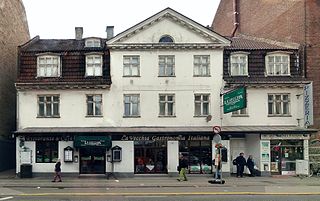
Falkoner Alle is one of the main streets of Frederiksberg in Copenhagen, Denmark. It runs from Frederiksberg Town Hall Square in the south to Ågade on the border with Nørrebro in the north, linking Allégade with Jagtvej. The street takes its name from the Royal Falconry which was located in the area. Remains of the buildings are still found behind the buildings at No. 112–120. Notable buildings on the street include the Frederiksberg Centret shopping center and the Falkoner Center hotel and conference centre.
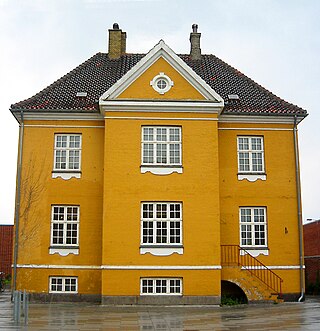
Flintholm is a modern neighbourhood in the Frederiksberg district of Copenhagen, Denmark. Located just south of Flintholm station, on the border with Vanløse, it is the result of a redevelopment of a former gasworks site which began in 2004 and is still ongoing. The neighborhood covers an area of about 10 hectares and consists of a mixture of housing, offices, retail and several minor green spaces. The only surviving building from the gasworks, The Yellow Villa, now serves as a local cultural centre.

Allégade is the oldest street in the Frederiksberg district of Copenhagen, Denmark. It runs from Frederiksberg Runddel to Frederiksberg Town Hall Square, along the east side of Frederiksberg Gardens, connecting Pile Allé to Falkoner Allé. The streetscape is, in spite of the central location, characterized by houses that are pulled back from the street with front gardens behind white fences. Several buildings are old country houses from the time when Frederiksberg was a summer destination outside Copenhagen. Along the northernmost part of the street, on its west side, is a narrow garden complex, Digterlunden with a statue of Holger Drachmann.
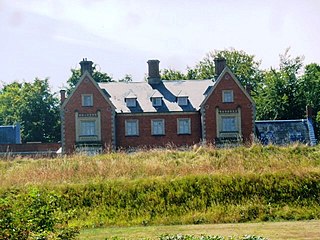
Enrum is a listed mansion on Strandvejen in Vedbæk, Rudersdal Municipality, some 20 kilometres north of Copenhagen, Denmark. The history of the property dates back to 1731 but the current main building was built in the 1860s to a design by Johan Daniel Herholdt. Enrum is today owned by nemlig.com founder Stefan Plenge.
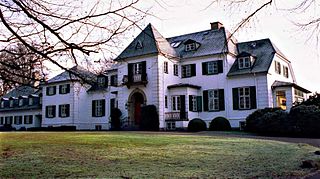
Rolighed is a former country house in Skodsborg, Rudersdal Municipality, approximately 16 km north of Copenhagen, Denmark. The history of the property dates back to 1780 but the current house is from 1927. Formerly associated with the Conservative People's Party, it now houses Mærsk's Center of Leadership.

Edelgave is a manor house situated just southwest of Smørumnedre, Egedal Municipality, 20 km northwest of central Copenhagen, Denmark. The current main building was designed by Andreas Kirkerup and is listed.
Bülowsvej is a street in the Frederiksberg district of Copenhagen, Denmark. It runs from Gammel Kongevej in the south to Åboulevard in the north, linking Madvigs Allé with Brohusgade. The University of Copenhagen's Frederiksberg Campus dominates the west side of the street with its large main building from 1895. The east side of the street is home to one of Denmark's oldest neighbourhoods of single family detached homes.
Vodroffsvej is a street in the Frederiksberg district of Copenhagen, Denmark. It follows the western shore of St. Jørgen's Lake, linking Gammel Kongevej in the south with Rosenørns Allé in the north. The embankment and lakeside path on the east side of the street is called Svineryggen.

Godthåbsvej is a street in the northwestern part of Copenhagen, Denmark. It begins at Bülowsvej in Frederiksberg as the direct continuation of Rosenørns Allé/Rolighedsvej and passes through Vanløse before reaching Bellahøj in Brønshøj. A metro station on the Copenhagen Metro City Circle Line is located at Aksel Møllers Have.

Nyelandsvej is a street in the Frederiksberg district of Copenhagen, Denmark. It runs from Falkoner Allé in the southeast to a roundabout at the north end of Dalgas Boulevard in the northwest. The more urban, eastern part of the street, between Falkoner Allé and Nordre Fasanvej, separates an area with Copenhagen Business School's Solbjerg Campus and Frederiksberg Centret to the south from the Svømmehal Quarter to the north. The western part of the street is passes the multi-purpose venue Keddelhallen and Frederiksberg Hospital before entering an area with Single-family detached homes.
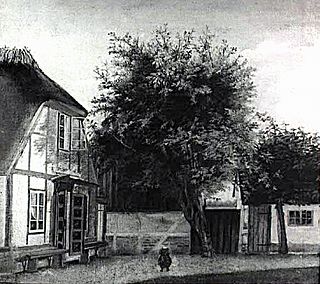
Falkonergården was a royal Danish facility for stabling of peregrine falcons for falconry located in Frederiksberg outside Copenhagen from 1670. It closed in 1810 and the buildings have been demolished except for one wing which is still seen in an alley off Falkoner Allé. Falkonergården is commemorated in Frederiksberg Municipality's shield as well as in the names of several buildings and public spaces.

Ladegården, or Københavns Ladegård was established as a farm under Copenhagen Castle by Christian IV in 1623 and was located roughly at the site of the present-day Radio House on Rosenørns Allé in Copenhagen, Denmark. The complex with later additions later served a range of different functions before it was demolished in the early 1920.

Christiansholm is a historic house in Klampenborg, Gentofte Municipality, some 10 km north of central Copenhagen, Denmark. It was built by the merchant Just Fabritius and is now owned by the businessman Fritz Schur.

Rolighedsvej is a street in the Frederiksberg district of Copenhagen, Denmark. It runs from Falkoner Allé in the northwest to Bülowsvej in the southeast, linking Godthåbsvej with Rosenørns Allé. The street is dominated by the University of Copenhagen's Frederiksberg Campus. It takes its name after Rolighed, a Rococo-style country house from 1770 which is now owned by the university.

Danasvej is a street in the Frederiksberg district of Copenhagen, Denmark, linking the Kampmannsgade embankment across St. Jørgen's Lake in the east with H. C. Ørsteds Vej in the west. The central, section of the street, from Vodroffsvej to Svend Trøsts Vej, is called Danas Plads but the street and square are continuously numbered. The Danas Plads buildings, built in 1906–1909 to a National Romantic design by Ulrik Plesner and Thorvald Bindesbøll, surrounds a rectangular, public space with greenery and a playground.
Grundtvigsvej is a street in the Frederiksberg district of Copenhagen, Denmark. It runs from Bülowsvej in the east to Falkoner Allé in the west. Grundtvigsvej School, a public primary school, is located at No. 11.





















